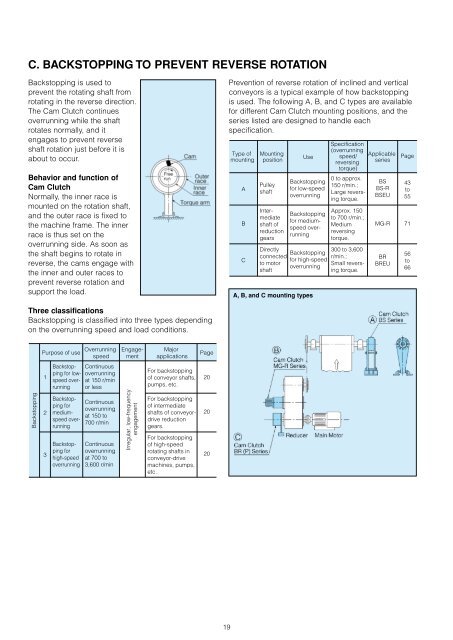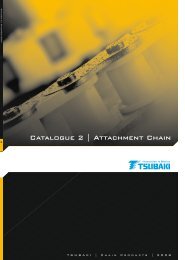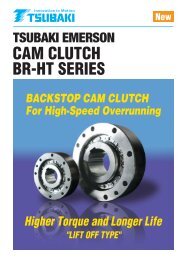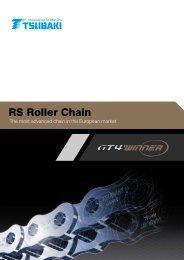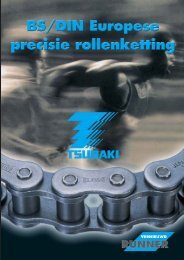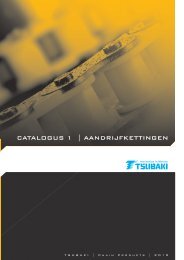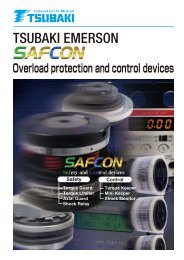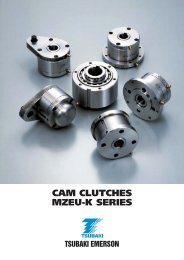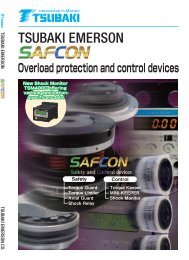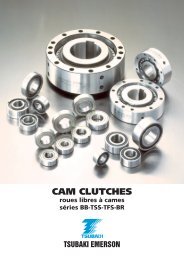CAM CLUTCH
CAM CLUTCH
CAM CLUTCH
Create successful ePaper yourself
Turn your PDF publications into a flip-book with our unique Google optimized e-Paper software.
C. BACKSTOPPING TO PREVENT REVERSE ROTATION<br />
Backstopping is used to<br />
prevent the rotating shaft from<br />
rotating in the reverse direction.<br />
The Cam Clutch continues<br />
overrunning while the shaft<br />
rotates normally, and it<br />
engages to prevent reverse<br />
shaft rotation just before it is<br />
about to occur.<br />
Behavior and function of<br />
Cam Clutch<br />
Normally, the inner race is<br />
mounted on the rotation shaft,<br />
and the outer race is fixed to<br />
the machine frame. The inner<br />
race is thus set on the<br />
overrunning side. As soon as<br />
the shaft begins to rotate in<br />
reverse, the cams engage with<br />
the inner and outer races to<br />
prevent reverse rotation and<br />
support the load.<br />
Prevention of reverse rotation of inclined and vertical<br />
conveyors is a typical example of how backstopping<br />
is used. The following A, B, and C types are available<br />
for different Cam Clutch mounting positions, and the<br />
series listed are designed to handle each<br />
specification.<br />
Type of<br />
mounting<br />
A<br />
B<br />
C<br />
Mounting<br />
position<br />
Pulley<br />
shaft<br />
Backstopping<br />
for mediumspeed<br />
overrunning<br />
Intermediate<br />
shaft of<br />
reduction<br />
gears<br />
Directly<br />
connected<br />
to motor<br />
shaft<br />
Use<br />
Backstopping<br />
for low-speed<br />
overrunning<br />
Backstopping<br />
for high-speed<br />
overrunning<br />
A, B, and C mounting types<br />
Specification<br />
(overrunning<br />
speed/<br />
reversing<br />
torque)<br />
0 to approx.<br />
150 r/min.;<br />
Large reversing<br />
torque.<br />
Approx. 150<br />
to 700 r/min.;<br />
Medium<br />
reversing<br />
torque.<br />
300 to 3,600<br />
r/min.;<br />
Small reversing<br />
torque.<br />
Applicable<br />
series<br />
BS<br />
BS-R<br />
BSEU<br />
MG-R<br />
BR<br />
BREU<br />
Page<br />
43<br />
to<br />
55<br />
71<br />
56<br />
to<br />
66<br />
Three classifications<br />
Backstopping is classified into three types depending<br />
on the overrunning speed and load conditions.<br />
Backstopping<br />
Purpose of use Overrunning<br />
speed<br />
1<br />
2<br />
3<br />
Engagement<br />
Backstopping<br />
for lowspeed<br />
overrunning<br />
Backstopping<br />
for<br />
mediumspeed<br />
overrunning<br />
Backstopping<br />
for<br />
high-speed<br />
overrunning<br />
Continuous<br />
overrunning<br />
at 150 r/min<br />
or less<br />
Continuous<br />
overrunning<br />
at 150 to<br />
700 r/min<br />
Continuous<br />
overrunning<br />
at 700 to<br />
3,600 r/min<br />
Irregular, low-frequency<br />
engagement<br />
Major<br />
applications<br />
For backstopping<br />
of conveyor shafts,<br />
pumps, etc.<br />
For backstopping<br />
of intermediate<br />
shafts of conveyordrive<br />
reduction<br />
gears.<br />
For backstopping<br />
of high-speed<br />
rotating shafts in<br />
conveyor-drive<br />
machines, pumps,<br />
etc.<br />
Page<br />
20<br />
20<br />
20<br />
19


